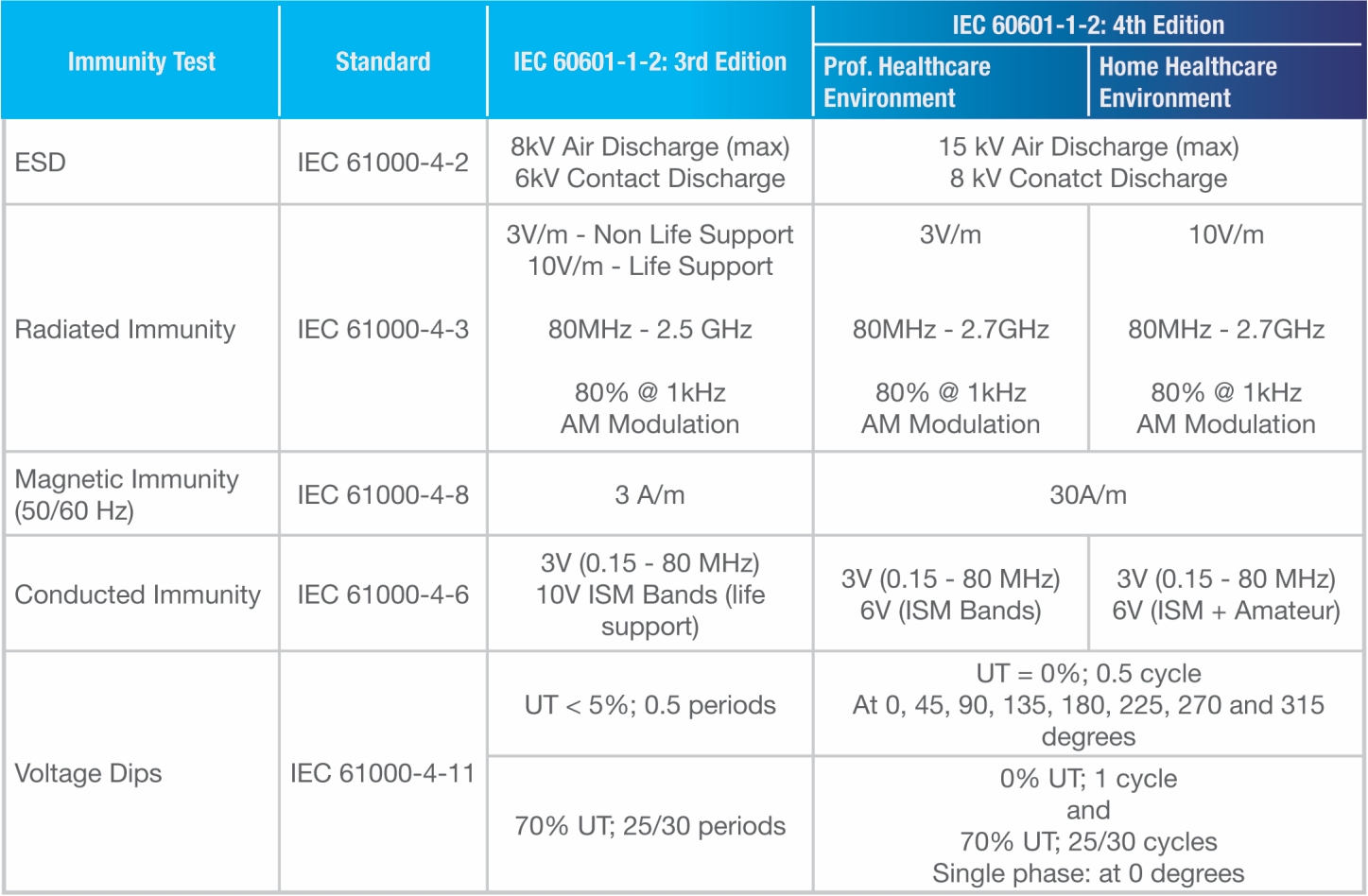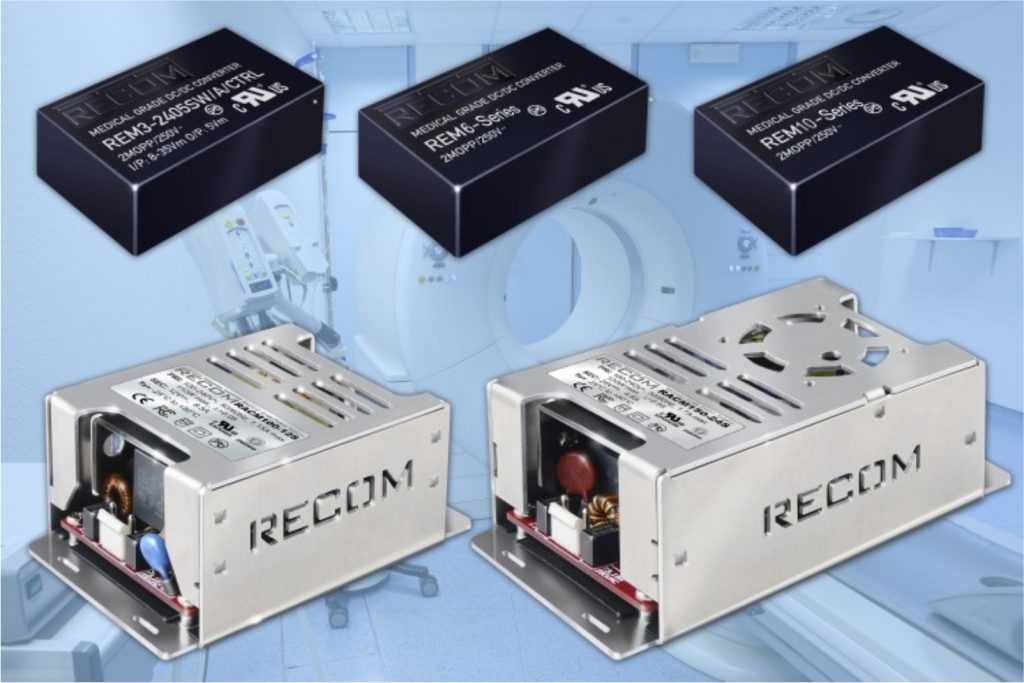“Better safe than sorry” must have been at the back of the minds of the members of the International Electrotechnical Commission (IEC) when they decided to revise the entire IEC60601-1 standard in 2012. In order to prevent any health hazards from EMC-related issues, IEC also revised its IEC60601-1-2 collateral standard in 2014. We wish to inform you briefly on how power supplies are affected by these revisions.

Medical technical devices are designed to provide best patient care and to promote fast and preferably full recovery. The relevant safety requirements are laid down in the highly complex and comprehensive IEC 60601-1 standard “Medical electrical equipment – Part 1: General requirements for basic safety”. As technology progresses, this standard is being regularly revised and updated. A complete revision of the standard was completed in 2012.
IEC 60601-1 3rd edition
The third edition of IEC 60601 focuses on the safety of operating personnel and patients. To assess medical electrical equipment, a new classification system (MOP – Means of Protection) has been introduced. The standard distinguishes between the safety of the operator and the safety of the patient, whereby the safety requirements for operators (MOOP – Means of Operator Protection) are slightly less onerous than those for patients and correspond more or less to those laid down in EN 60950-1 “Information technology equipment – Safety”.

Much more stringent requirements apply to patient protection (MOPP – Means of Patient Protection), especially as regards insulation (see table 1). To protect patients against electric shocks, two separate insulation barriers must be implemented in all medical electrical equipment.
Minimum leakage and stray currents
We all know that electric currents through the body are extremely dangerous and often result in death. For a healthy person, currents as low as 40mA can be fatal. For a person who is anaesthetised or weakened by an illness, this threshold is likely to be much lower. To protect patients, power supplies for medical devices must meet stringent requirements as regards leakage and stray currents. The limit values vary depending on the type and nature of applied part (AP) that is brought into direct contact with the patient’s body. Table 2 shows the applicable limits for normal condition (NC) and single fault condition (SFC).
Medical devices safety classification – CF, BF and B
Type CF (Cardiac Float) is the most stringent classification. It applies to all applications where the applied part is in direct conductive contact with the heart or could come into such direct contact in the event of a device fault. Such parts include for instance heart-lung machines and external pacemakers.

The next class is BF (Body Float) with slightly less onerous requirements. It covers applied parts other than CF parts that are in direct contact with the patient. In this class, we find incubators, ultrasound equipment and various diagnostic devices.
Class B (Body) covers applications where the equipment does not come into direct contact with the patient, such as LED lighting systems, medical lasers, etc.
Type B applied parts may be connected to earth, while Type BF and CF are ‘floating’ and must be separated from earth.
EMC regulations to become more stringent
When it comes to life-supporting or life-saving devices, faults and malfunctions caused by electromagnetic or radio interference could obviously be fatal. In order to prevent any such incidents, a completely revised version of the IEC60601-1-2 “Medical electrical equipment – Part 1-2: General requirements for basic safety and essential performance – Collateral standard: Electromagnetic disturbances – Requirements and tests” was introduced in early 2014.
The US Food & Drug Administration (FDA) has already decided that the new rules are to be implemented in the national legislation, which will happen on April 1st, 2017. In Europe, the European Committee for Electrotechnical Standardization (CENELEC) has made it clear that it intends to adopt the IEC standard as the basis for a new European standard. While no deadline has yet been set, it is however expected that the new regulations will come into force in 2017/2018.
While the 3rd edition of the IEC standard on EMC distinguished between life-supporting and non-life-supporting equipment, this distinction is now gone. For the new standard, only the application environment of the equipment is relevant. It distinguishes between three such environments to which different limit values apply:
- Healthcare establishments
- Domestic environment
- Special environments (e.g. army, heavy industry)
The 4th edition stipulates much more stringent requirements as regards electromagnetic immunity. Equipment must now be immune to HF fields up to 2.7GHz, an increase by 0.2GHz. In addition, the standard wants to prevent damage caused by electrostatic discharge, and the relevant limits have been increased accordingly. For contact discharge, the threshold went up from 6kV to 8kV. For air discharge, it has been increased from 8kV to 15kV. Table 3 provides an overview of the main changes affecting power supplies.

Risk management files
Apart from technical changes, the new standard now demands a formal risk analysis according to ISO 14971, which might pose a challenge to certain power supply manufacturers. Based on a risk index matrix, all risks that might potentially arise from the power supply must be analysed and weighed. The matrix must take into account the occurrence, probability (unlikely to frequent) and impact (insignificant to catastrophic) of the potential risk, based on a rating system from 1 to 5 in each category. If the risk index is ≤6 (probability x impact), the risk is deemed acceptably low. If the risk index is higher, suitable protection measures must be taken to reduce it.
For power supply manufacturers, these risk are often difficult to assess as the end device, which obviously has a major influence on the risk level, is often not known. When purchasing a power supply, medical devices suppliers are advised to obtain the respective risk management reports from the power supply manufacturer. Only if these documents are in place is it possible to deal with the power supply as a “black box”, which speeds up the certification process for the actual medical technical device.
Power supplies for medical technical equipment
 In order to meet the above requirements, in particular with regard to insulation and leakage currents, a combination of high-quality AC/DC power supplies for medical application and DC/DC converters is often the most efficient solution. This approach makes it easier to meet the stringent requirements of double patient protection (2x MOPP).
In order to meet the above requirements, in particular with regard to insulation and leakage currents, a combination of high-quality AC/DC power supplies for medical application and DC/DC converters is often the most efficient solution. This approach makes it easier to meet the stringent requirements of double patient protection (2x MOPP).
RECOM offers a broad range of products that are certified for use in medical electrical equipment. Apart from DC/DC converters from 0.25W to 15W, the company also manufactures AC/DC power supplies for power ranges up to 150W. They are certified according to EN/UL 60601-1 3rd edition and EN/UL 60950-1, and do not contain any hazardous substances according to the RoHS2 and REACH Directives. Another plus is the 5-year warranty that RECOM grants on all these products.








